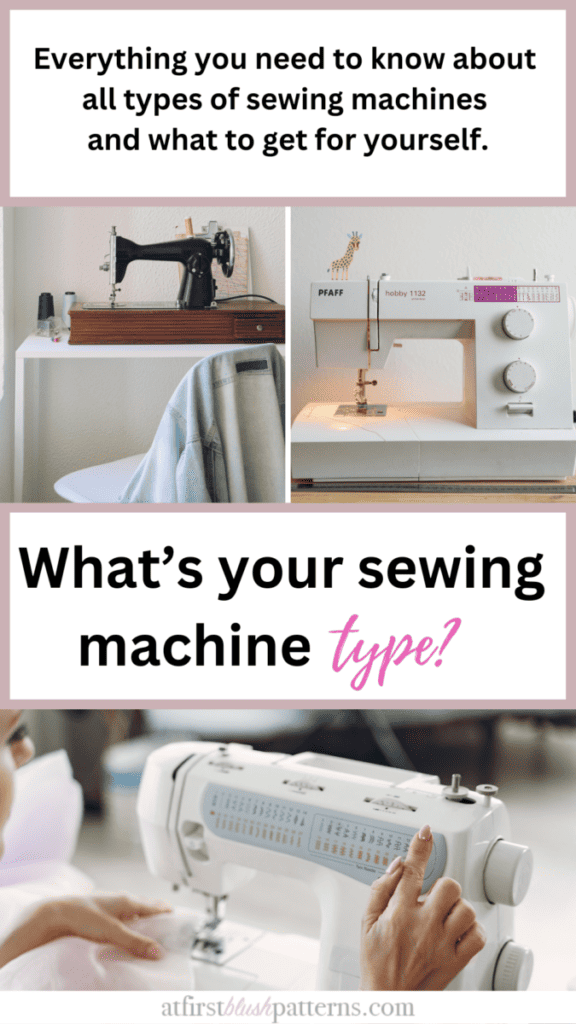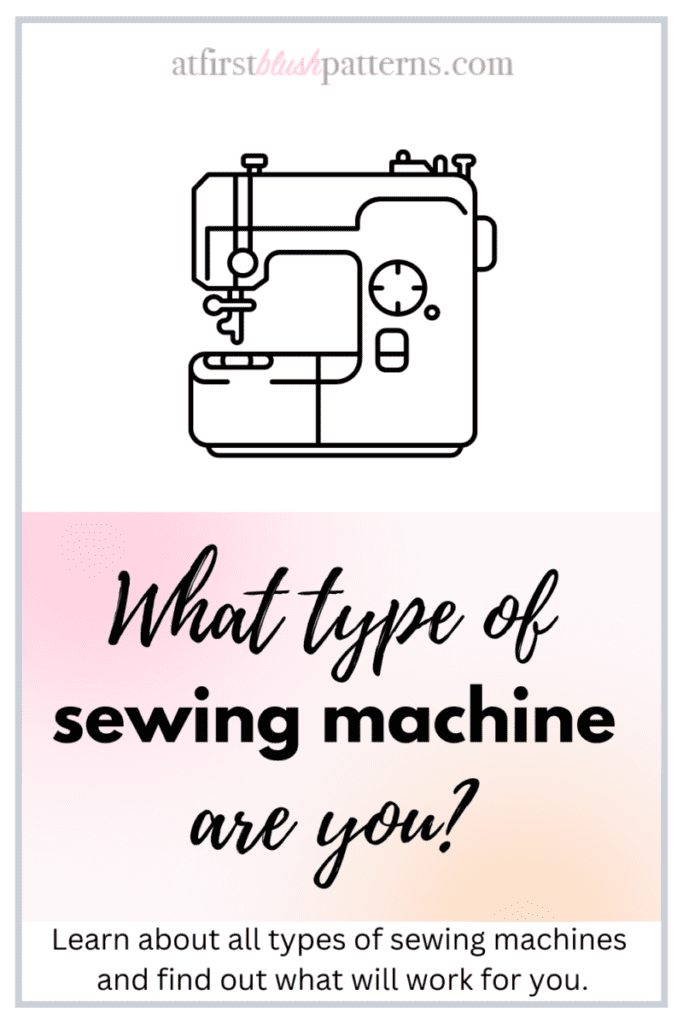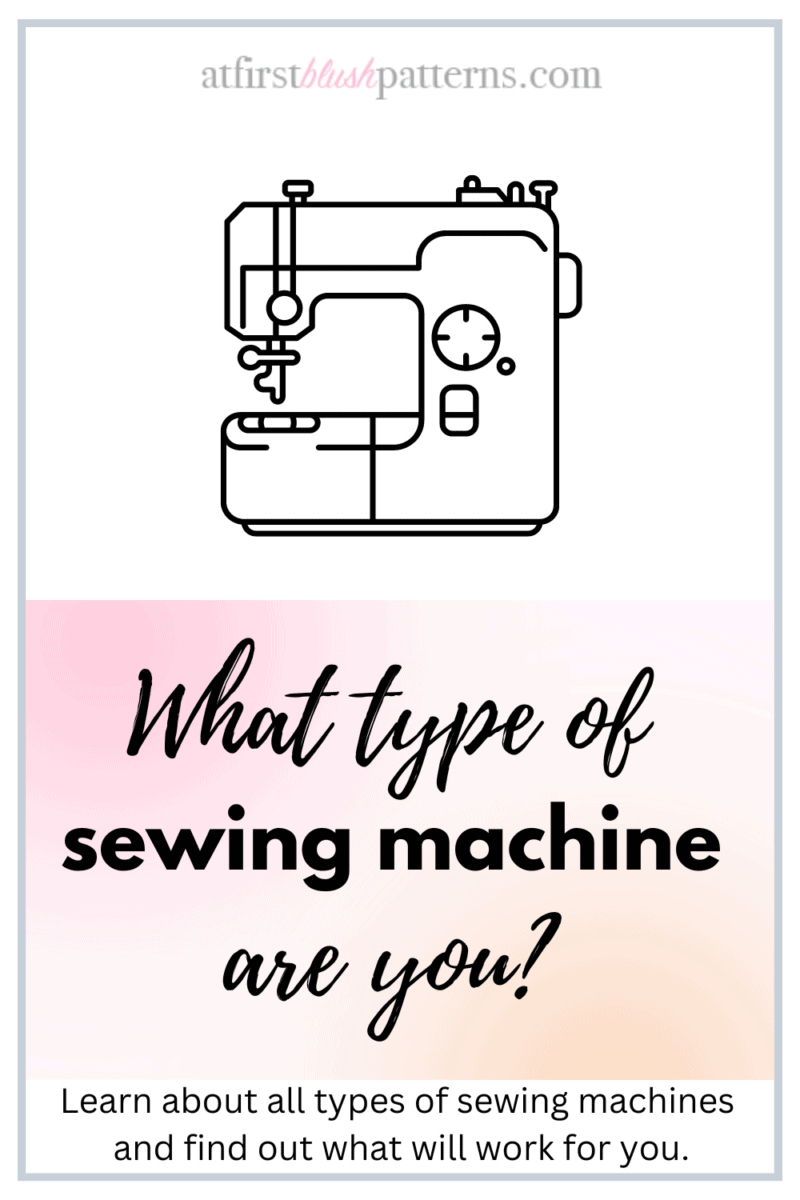If you are interested in taking up sewing as a hobby you will probably be pleasantly surprised to find out that there are many different types of sewing machines available on the domestic sewing machine market. You can find anything from a sewing machine that will only stitch a single straight line to machines that are so advanced you can upload your on designs. You might also be interested to know that there are several types of sewing machines used on the industrial side of sewing. Many industrial machines are designed to sew something very specific like a buttonhole or a bar tack. If you are interested in learning about all of these types of sewing machines look no further. I have compiled a detailed list of all of these types of sewing machines for you to explore.
This post contains affiliate links. When you click and make a purchase from these links, we might get a commission. It doesn’t cost you anything extra!
Different Types of Sewing Machines
The list below will define roughly 20 plus different types of sewing machines in the domestic and industrial market. In the domestic sewing machine market you will find these types of machines:
- Mechanical sewing machine/Electric Sewing Machine
- Manual sewing machine
- Computerized sewing machine
- Quilting sewing Machine/Long arm quilting sewing machine
- Embroidery machine
- Mini sewing machine
- Hand sewing machine
- Portable sewing machine
- Overlock or Serger sewing machine
- Cover stitch machine
In the industrial sewing machine market you will find these types of sewing machines:
- Heavy-duty sewing machine
- Cover stitch machine
- Lock stitch machine
- Chain stitch machine
- Blind stitch Machine
- Button sewing machine
- Buttonhole sewing machine
- Bar tack machine
- Leather machine
- Zigzag machine
- Cylinder bed sewing machine
- Flat bed sewing machine
- Safety stitch machine
What is the most common type of sewing machine?
For domestic use, the most common type of sewing machine is a mechanical or electric sewing machine. These are perfect home sewing machines because of their sewing capabilities, durability and price point. This type of sewing machine is easy to use, can be plugged in for power and has some automated features to make sewing easier.
Interested to find out what is the best type of sewing machine for lingerie makers? Read this article on Best Sewing Machines for Lingerie Makers.
For industrial use, the most common type of sewing machine is a heavy-duty straight stitch sewing machine. The straight stitch is needed for an abundance of sewn products. These types of sewing machines are incredibly fast, durable and high quality. The heavy duty straight stitch sewing machine allows for a mass production of sewn products in a timely manner.
Industrial sewing machine vs. Domestic Sewing Machine
What is the difference between an industrial sewing machine and a domestic sewing machine? The main difference is that the industrial sewing machine is designed to sew for mass production while the domestic sewing machine is designed for home use. Industrial sewing machines are usually dedicated to one specific step in the sewing process while the domestic machine can perform a variety of steps. Even though the domestic sewing machine can perform a variety of steps it will not do this to the level of precision and speed of an industrial sewing machine. However, the domestic sewing machine will sew at a high quality level for everyday clothing or other sewn projects.
Domestic – Types of Sewing Machines
Mechanical sewing machine/Electric sewing Machine
A mechanical sewing machine is considered a basic sewing machine. It is an electric machine that operates using a system of knobs and dials. These knobs and dials will allow the user to adjust the settings and functions. For example, you will likely have a dial that will display a variety of stitches. You simply turn that dial to the stitch you would like to use. The same goes for thread tension and stitch length. You will find that mechanical sewing machines do not have an internal computer system or a digital screen that you will find with newer technology. However, manual sewing machines are still a very popular choice for sewist today. These are great sewing machines that are great for a beginner or someone who wants a traditional no nonsense machine.
Manual sewing machine
A manual sewing machine is a machine that does not rely on electricity to operate. Instead the user must use a hand spinning wheel or a foot pedal to operate the sewing machine. While you can still find a vintage manual sewing machine (sometimes referred to as a treadle) they have moved more into a novelty category rather than actual utility. The vintage design is aesthetically pleasing and would be a nice piece for any sewing enthusiast to have in their collection. Besides the vintage appeal, a manual sewing machine is tedious and time consuming to operate. It will not provide the same results as a mechanical sewing machine or a computerized sewing machine. However, this machine is still useful in areas of the world that may have inconsistent electricity.
Computerized sewing machine
A computerized sewing machine is the next step in technology from the mechanical or electric sewing machine. Instead of manually adjusting knobs and dials you can refer to an LCD display and a series of buttons. These types of sewing machines are on the pricey side but they offer time saving features such as automatic needle threading, automatic thread cutters and a variety of stitches. Stitches can include not only your basic stitches but embroidery stitches, quilting stitches and for some you can even download a custom embroidery design. Computerized sewing machines are plentiful on the market and can be found in a broad range of pricing to fit most budgets.
Quilting Sewing Machine/Long arm quilting sewing machine
A quilting sewing machine is a special type of sewing machine for sewing large quilts. These machines feature a long arm which is basically a table that extends from the base of the sewing machine to allow a greater amount of fabric to pass through the sewing machine. The long arm feature allows the quilter to have greater control of their project. Quilting sewing machines can also handle a greater amount of fabric as quilts can be sewn in a variety of weights. Quilting sewing machines offer the same functions as your standard sewing machine. You can find quilting machines that are mechanical or electronic as well as computerized quilting sewing machines.
Embroidery machine
Embroidery is ”the art or process of forming decorative designs with hand or machine needlework”, according to Merriam-Webster Dictionary (Source). An embroidery sewing machine is an advanced sewing machine. This type of sewing machine will come with a variety of preloaded embroidery designs and will typically allow you to upload your own designs. An embroidery machine does not have the functions of a standard sewing machine although you may be able to find some computerized sewing machines with embroidery capabilities on a smaller scale. Embroidery sewing machines automate the needlework process that would otherwise take the modern sewist far longer by hand. Embroidery sewing machine technology is far advanced because of this automation process making this type of sewing machine very pricey. Embroidery machines are available directly to the consumer and for industrial use.
Mini sewing machine
Mini sewing machines are small scale mechanical sewing machines. They are very light and will not have a metal frame like some of your higher quality mechanical sewing machines. Mini sewing machines have very basic features such as straight line stitch or very limited stitch capabilities. This type of sewing machine will likely not have the ability to backstitch or be able to sew thicker fabrics or multiple layers of fabric. Mini sewing machines are ideal for a beginner sewist. It can also be great for a household sewing machine if you are making minor repairs to clothing or linens. If you are looking for a simple machine to sew simple projects and a very low price point this would be a great introductory sewing machine. A mini sewing machine would also be great if you need something portable. These machines come in a variety of colors and styles. They are very easy to find on Amazon.
Hand sewing machine
Handheld sewing machines are extremely basic sewing machines. They fit in your hand and therefore are limited to a straight stitch on thin fabric. This is the type of sewing machine you could use to sew or repair a hem or cuff. A handheld sewing machine is really only capable of sewing thin fabric. This type of machine is probably something you would only use if you need to sew something in a pinch or if you are traveling and are concerned with needing to repair some of your clothing items. Handheld sewing machines are lightweight but not sturdy. This type of sewing machine is very inexpensive and easy to find.
Portable sewing machine
I would classify mini sewing machines and handheld sewing machine under portable sewing machines. These sewing machines are lightweight and small – even small enough to hold in one hand. The can complete basic stitches like a straight stitch or in some cases a zigzag stitch. They are great is you need travel with a machine or need to make a simple repair or alteration. Otherwise, these machines are not very sturdy and because they tend to be on the lower end for quality they may jam easily or break. These machines come in at a very low retail price and are probably idea for the casual sewist not looking to make a big investment.
Overlock or Serger sewing machine
The overlock or serger sewing machine typically comes with 4 spools of thread, 2 needles and a cutter. This type of sewing machine uses 4 threads and two needles simultaneously. The outcome of the 4 threads and two needles is a stitch that overlocks the edge with a very sturdy stitch. Overlock or serger sewing machines are ideal for stretch fabrics such as knits and items like activewear, swimwear and lingerie. This type of stitch is very durable and offers a professional look on garments and other sewn home goods for home sewing. These sewing machines typically come with a cutter which cuts off the excess seam allowance from the garment. This leaves a nice edge that isn’t bulky. You will find this type of sewing machine is very fast so it takes some practice to get used to the speed. Once you get used to it you will find many uses for this sewing machine. I definitely love my overlock/serger sewing machine, I just wish it was easier to thread!
Cover stitch machines
Cover stitch machines are for the serious sewist. The cover stitch machine is a specialized sewing machine with the function of a strong stitch that can move and stretch. This type of sewing machine is mainly used to finish hems on knits, binding, topstitching and to add elastic, lace or decorative trim to a garment or other sewn projects such as quilts. The cover stitch machine is wonderful for experienced sewists who make a variety of sewn projects either for themselves or others. This type of sewing machine will offer a very professional, clean finish to your sewing projects. They are also very pricey but readily available for purchase online. You can find a cover stitch sewing machine on the domestic market for home sewing and on the industrial market.
Industrial – Types of Sewing Machines
Heavy-duty sewing machines
Heavy-duty sewing machines are sewing machines made specifically for mass production. The most common type of heavy-duty sewing machine is a single straight stitch machine. You will find this machine; like the other industrial sewing machines, built-in to a table creating it’s own workstation. Heavy-duty sewing machines are fast and powerful. They require an experienced handler to be able to guide the fabric precisely. Heavy-duty sewing machines are meant to only complete one task to keep up with mass production. A mass number of garments or textiles can quickly go through production with one person sewing only one step then passing the batch on to the next sewing technician. We will detail more industrial sewing machines below.
Lock stitch machine
A lock stitch industrial sewing machine is the most common industrial sewing machine. This type of sewing machine sews a strong and sturdy straight stitch or zigzag stitch which are common stitches on garments and textiles. This sewing machine is very fast and is meant to complete multiple straight or zigzag stitches in the shortest amount of time possible. It is a very straightforward machine with a spool of thread on the top and a bobbin spool on the bottom just like your home sewing machine.

Chain stitch machine
A chain stitch sewing machine is a type of industrial sewing machine that can only stitch a straight stitch or a zigzag stitch using a chain stitch technique. This machine can use one spool of thread or two spools of thread as well as one needle or two needles. A chain stitch is a type of stitch where the thread is looped under the fabric then around itself creating a chain appearance. A chain stitch machine can also create binding or decorative stitching such as embroidery.
Blind Stitch Machine
A blind stitch sewing machine is used for hemming an invisible stitch. You will find this is necessary for many mass produced garments that require a smooth finish. This is the only function of this sewing machine but is very efficient and an important sewing operation in mass production.

Button sewing machine
A button sewing machine sews a variety of buttons onto a garment or textile. Sewing buttons by hand can be tedious and time consuming. It is still a tough job when using a standard home sewing machine. Within industrial sewing there is no time to waste when sewing buttons. Garments and textiles must be sewn quickly and efficiently. Sewing buttons onto a mass produced garment or textile is no different.

Buttonhole sewing machine
When sewing in buttons you need buttonholes. The buttonhole sewing machine uses a lock stitch or a chain stitch to sew a mass number of buttonholes. This type of sewing machine can sew buttonholes of different sizes and maintain precision.

Bar tack machine
A bar tack is a type of stitch that reinforces stitching in areas of a garment that experience more stress while worn. For example, you will notice this around pockets, waistbands, and belt loops. A bar tack is commonly used on heavier fabrics that are harder to stitch together. A bar tack is often needed for the extra security to ensure the garment does not fall a part on the wearer. This type of sewing machine is a heavy-duty sewing machine that creates this very strong and reliable stitch. It is used heavily in the mass production of pants or any item that has heavy fabric with vulnerable stitch points.
Leather machine
Leather sewing machines are a specialized machine for industrial use. They handle a variety of leather goods therefore these types of sewing machines must have a strong motor, a special needle to withstand the thickness of leather, a walking foot and an adjustable presser foot. Leather can come in a range of thicknesses and textures therefore this machine must be able to adjust to any type. The walking foot/presser foot are key in being able to navigate the thickness and texture in leather materials.
Zigzag machine
Zigzag sewing machines purpose is to sew a zigzag stitch quickly and efficiently for mass production. A zigzag stitch is commonly used in stretchy garments such as swimwear, dance wear, lingerie or any other garment or textile that requires elastic. You will typically find a zigzag stitch in bras and underwear. An industrial zigzag stitch will be stronger that the zigzag stitch on a home sewing machine but they have the same function. The zigzag stitch is a very strong stitch so it is also used to attach appliqués and decorative embroidery to garments and textiles.
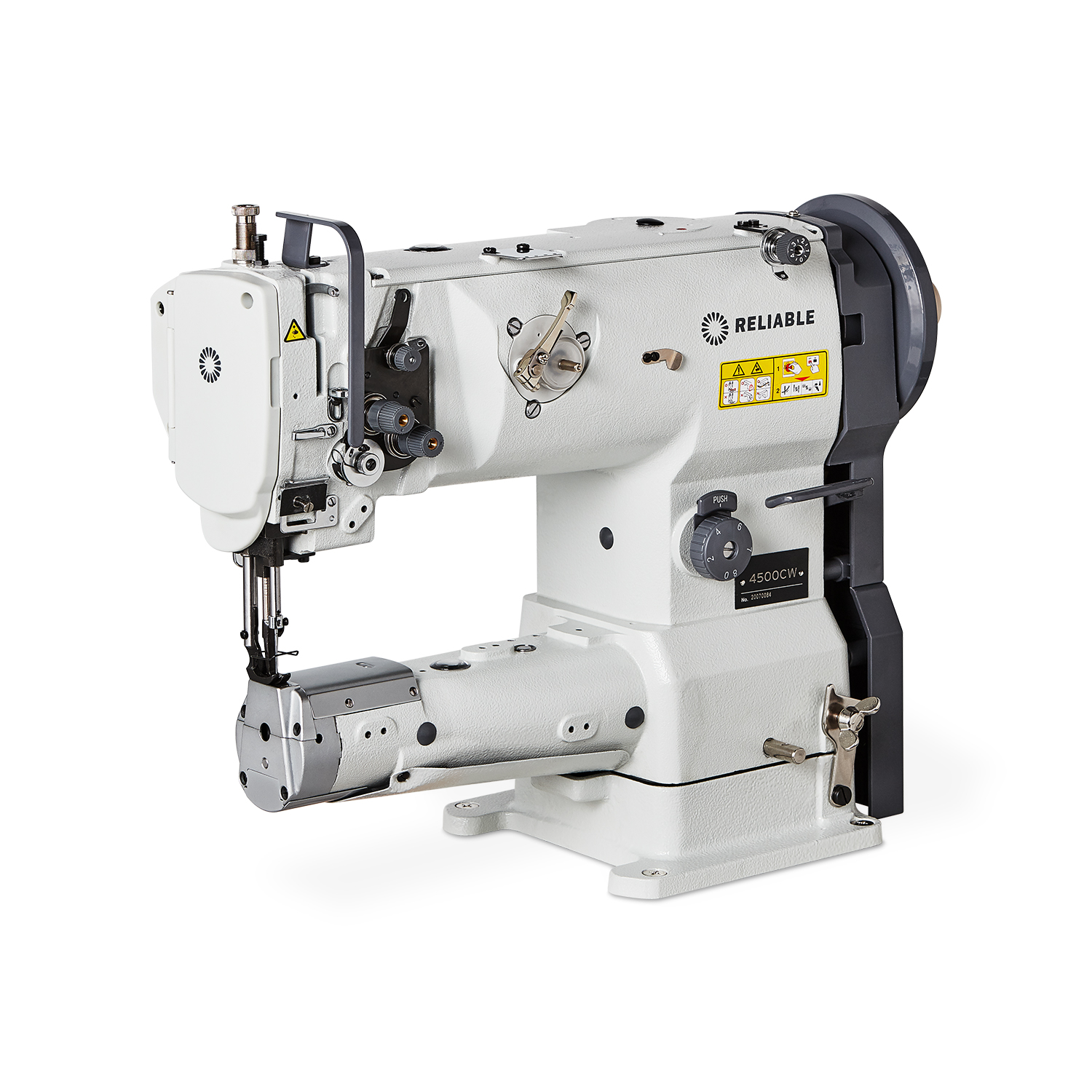
Cylinder bed sewing machine (Type of Flat seam sewing machine)
A cylinder bed sewing machine is a type of flat seam sewing machine that uses a cylinder bed to sew round items that are small. This type of sewing machine creates a flat seam on each side of the rounded item and is typically used on knit fabrics that can be flimsy or small garment pieces.
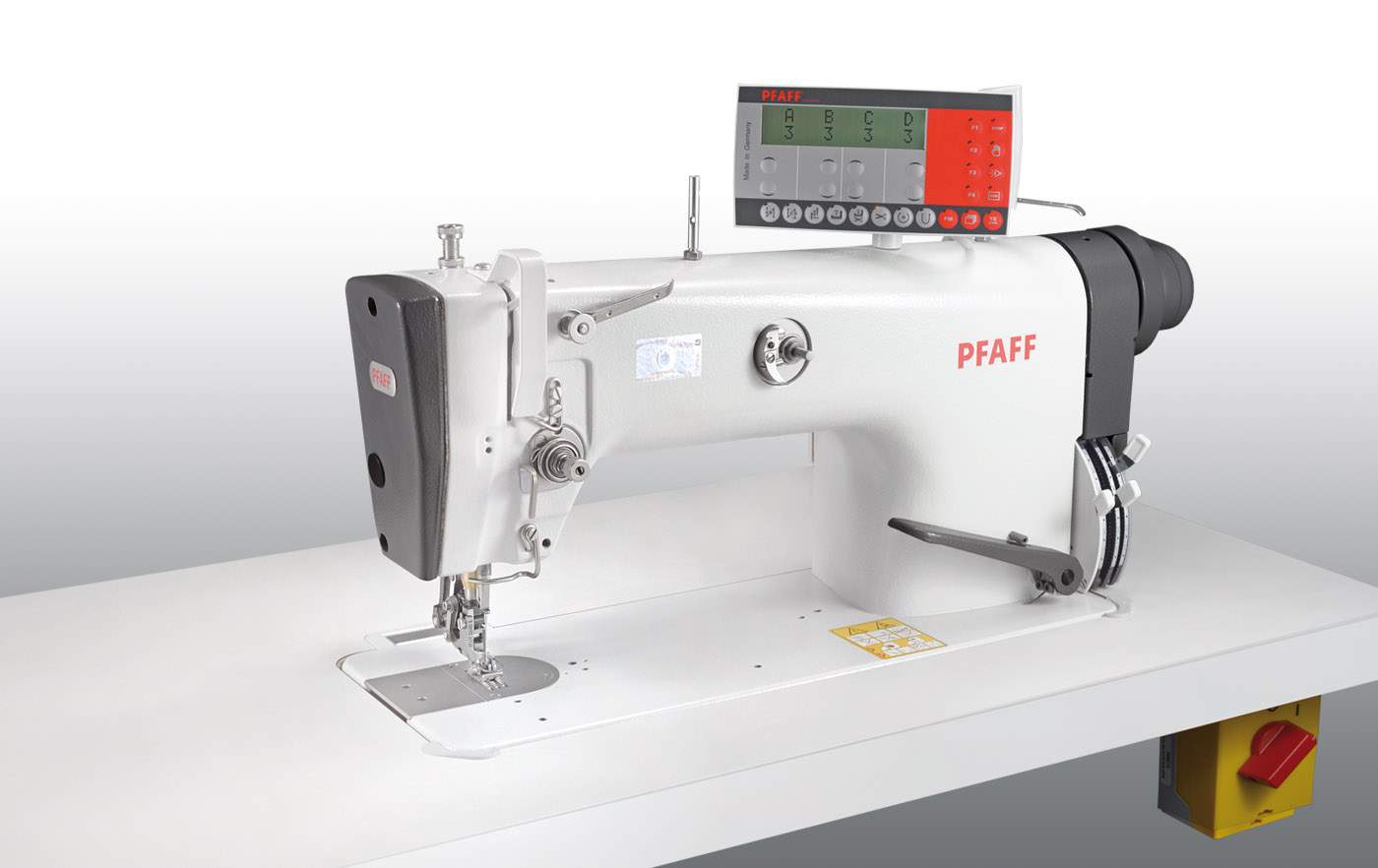
Flat bed sewing machine (Type of Flat seam sewing machine)
The flat bed sewing machine acts just like the cylinder bed sewing machine but it has a flat bed instead of a cylinder bed. It is typically used to bind cut edges together for larger garments and textiles specifically with knit fabrics.
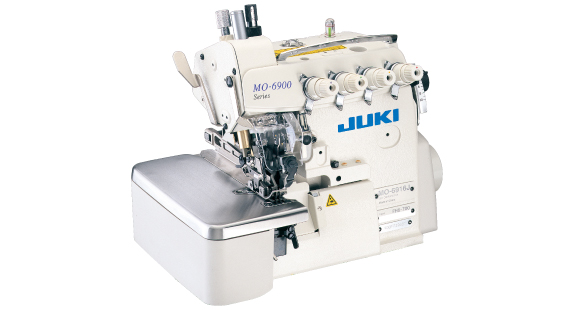
Safety stitch machine
A safety stitch sewing machine brings together the capabilities of a three-thread overlock or serger sewing machine and a two-thread chain stitch sewing machine. This type of sewing machine acts as an overlock or serger sewing machine in that the purpose of this sewing machine is to neaten up edges and to keep seams clean. This is a very strong and reliable industrial sewing machine offering two levels of durability for seam lines. A safety stitch is a very common stitch in mass production. However, you can purchase this sewing machine separately or combined with an overlock or serger sewing machine.
Vintage – Types of Sewing Machines

Treadle sewing machine
Treadle sewing machines have a long and fascinating history. They are the first sewing machine to become a household item. A treadle sewing machine is completely powered by the user. The user presses a foot pedal back and forth providing mechanical power to the sewing machine. These machines were very basic; the first treadle stitched only a chain stitch. Despite this machine’s ability to only stitch a chain stitch it opened the doors for the beginning of mass produced garments and textiles. This machine also made it easier for home sewing which was very common at that time to be done by hand.
Singer sewing machines
Singer sewing machines were the first sewing machines created in the United States. The Singer sewing machine was a treadle powered lock stitch machine that eventually advanced into electric powered machines. Singer sewing machines became the most popular home sewing machine around the world. Singer has since sold its brand to Pfaff Sewing Machines, a German based sewing machine company.
Additional Questions – Types of Sewing Machines
How to choose the right type of sewing machine for you
When choosing a sewing machine you want to consider many factors like what are you using it for, what is your budget, how much will you be using it and what do the reviews say about it. If you are clear on these questions you can find a great sewing machine.
For our specific recommendations check out our Recommended Sewing Machines.
How to choose the right type of sewing machine for a beginner
If you are a beginner to sewing and not sure how much time, money and energy you want to invest in a sewing machine I would suggest something that is no more than $150. You can find great basic mechanical sewing machines for around $100 on Amazon or Walmart. It would also be a good idea to wait for a sale to get an even better deal. You should also consider the return policy in case you quickly find out sewing is not for you. Otherwise, you will need consider the stitch types, presser foots, automatic threading and automatic bobbin winding. Some machines will only do this manually which is fine but tedious.
For more information on Sewing Machines for Beginners take a look at this article:
Most Needed Sewing Tools for Beginners
Where to find domestic sewing machines?
You can easily find domestic sewing machines on Amazon, Walmart and Joann’s.
Where to find industrial sewing machines?
You can purchase some industrial sewing machines on Amazon or directly through the specific branded retailer. These are high priced items so it is import to get quotes for several dealers before you purchase.
Where to find vintage sewing machines?
You can find vintage sewing machines on eBay, flea markets, and auction houses. You may even be able to find some at estate sales or facebook marketplace.
Conclusion – Types of Sewing Machines
There are certainly many different types of sewing machines on the market. Just on the domestic sewing machine market there are a variety available to the home sewist. The industrial sewing machine market is fascinating for its individual technology specific to each machine. Mass production of garments and textiles is not easy feat. Sewing machines will continue to improve and evolve. As technology advances so will the types of sewing machines we will see in both markets. As a home sewist, I’m excited to see what new domestic sewing machines come out next!
Pin for later! Guide to Types of Sewing Machines
